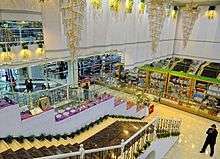Pyongyang Department Store No. 1
| Pyongyang Department Store No. 1 | |
|---|---|
.jpg) Pyongyang Department Store No. 1 | |
 Location in Pyongyang | |
| General information | |
| Address | Sungri Street |
| Coordinates | 39°1′20.14″N 125°45′11.42″E / 39.0222611°N 125.7531722°E |
| Design and construction | |
| Architect | Yun Ko-gwang[1] |

The Pyongyang Department Store No. 1 is a major retail store in Pyongyang, North Korea. On Sungri Street near Kim Il-sung Square in downtown Pyongyang,[2] it is one of the largest retail stores in the country and is often the site of large commodity exhibitions.[3]
The store, along with two others, are run reportedly jointly with Chinese business partners.[4]
Shopping
The store offers a variety of items including electronics, clothing, furniture, foodstuffs,[5] kitchenware, and toys.[2] As of 2013, approximately 70 percent of the items in the store were produced domestically.[6] The store is also one of several official tourist stops in the city.[7] Department Store No. 1 accepts only local currency.[8]
Swedish journalist Caroline Salzinger described her visit to the department store as a tourist: Upon arrival, the store was closed.[9] One of the tour guides accompanying her tried to distract her, while the other one rushed in to get the doors opened. When opened, the guide had to scramble passers-by to occupy the store as "shoppers". The moment they step in, the escalator is started.[10] The shoppers appear clueless as to how to act in a department store. When after great pains Salzinger managed to purchase the goods she wanted,[11] the cashier is confused and will not hand her a plastic bag for her items: "We look at each other in the eyes. She knows that something is wrong, and that not everything is like it should, but she does not know what it is."[12]
According to Salzinger, a Western diplomat monitored the department store for one hour and saw no one come out with purchased items.[11]
See also
References
- ↑ Choe Kwang (April 2014). "50-Year Devotion to Education". Democratic People's Republic of Korea. No. 700. p. 29. ISSN 1727-9208.
- 1 2 Hokkanen, Jouni (2013). "Pohjois-Korea: Matkailijan opas" [North Korea: Traveler's Guide]. Pohjois-Korea: Siperiasta itään [North Korea: East of Siberia] (in Finnish). Helsinki: Johnny Kniga. p. [10]. ISBN 978-951-0-39946-0.
- ↑ "Commodity Exhibition Held at Pyongyang Department Store No. 1". Korean Central News Agency. December 6, 2012. Retrieved July 6, 2013.
- ↑ Jae Cheol Kim (Nov 1, 2006). "The Political Economy of Chinese Investment in North Korea". North Korean Economy Watch. Retrieved July 6, 2013.
- ↑ Pak Won Il (Feb 25, 2012). "North Koreans Experience The Marvels Of A Supermarket Firsthand". Business Insider. Retrieved July 6, 2013.
- ↑ Curtis Melvin (Feb 22, 2013). "North Korean products in department stores on the rise". North Korean Economy Watch. Retrieved July 6, 2013.
- ↑ "Kumgangsan Tour". Koryo Tour Group. Retrieved July 6, 2013.
- ↑ e.g. Andrei Lankov, Money matters: the three-tiered system of the 1980s North Korean currency, NKNews 28 May 2014;http://www.nknews.org/2014/05/money-matters-the-three-tiered-system-of-1980s-north-korean-currency/ and Rob York, Black market cash, The real value of N. Korean Won, in: NKNews, 1 September 2014; http://www.nknews.org/2014/09/black-market-cash-the-real-value-of-n-korean-won/
- ↑ Salzinger 2008, p. 47.
- ↑ Salzinger 2008, p. 48.
- 1 2 Salzinger 2008, p. 49.
- ↑ Salzinger 2008, p. 50.
Works cited
- Salzinger, Caroline (2008). Terveisiä pahan akselilta: Arkea ja politiikkaa maailman suljetuimmissa valtioissa (in Finnish). Translated by Lempinen, Ulla. Jyväskylä: Atena. ISBN 978-951-796-521-7.